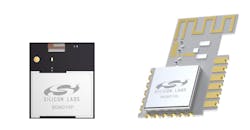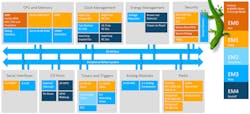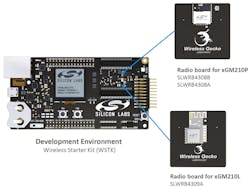Silicon Labs’ Gecko Series 2 wireless modules target connected IoT devices. The xGM210P is designed for line-powered solutions while the xGM210L is optimized for connected LED light bulbs (Fig. 1). They utilize the same SoC, but the xGM210L is designed to allow for orientation of the built-in antenna to provide optimum operating conditions within a light bulb. The modules can handle temperatures up to 125°C.
1. The xGM210P (left) is designed for line-powered solutions while the xGM210L (right) is optimized for connected LED light bulbs.
The modules leverage the EFR32xG21 SoC with a Cortex-M33 processor that has DSP and FPU support (Fig. 2). The processor supports Arm TrustZone and Silicon Labs included its own dedicated security core. The hardware crypto acceleration supports AES (128/192/256), SHA 1, SHA 2 (SHA 224/SHA256), ECC (256 bit), and ECDSA (256) and ECDH (p192, p256), HMAC, and J-PAKE. It has a true random number generator (TRNG) with a high entropy source that’s compliant with NIST SP 800 90A/B/C and AIS 31.
2. The modules are based on an EFR32xG21 SoC with a Cortex-M33 processor. The secure element provides secure storage and secure boot support.
The system supports secure boot with a root of trust and secure loader. There’s also support for secure debug. A secret key can be used to lock and unlock the debug support. This can prevent debugging in the field, but it can be enabled for diagnostic purposes.
The SoCs incorporate up to 1024 kB of flash storage and 96 kB of RAM. Peripherals include three USART, a pair of I2C ports, two 16-bit timers and one 32-bit timer, plus a pair of watchdog timers and a RTCC. On the analog side, there are a pair of comparators and a 12-bit, 1-Msample/s SAR ADC.
The xGM210P transmitter delivers up to +20 dBm with −104 dBm sensitivity at 250-kb/s O-QPSK, −105 dBm sensitivity at 125-kb/s GFSK, and −97 dBm sensitivity at 1-Mb/s GFSK. And the xGM210L module provides up to +12.5 dBm with −104 dBm sensitivity at 250-kb/s O-QPSK, −104 dBm sensitivity at 125-kb/s GFSK, and −97.5 dBm sensitivity at 1-Mb/s GFSK. The wireless support can handle Bluetooth 5.1 and Bluetooth mesh. It also will support Zigbee 3.0 and Thread. Bluetooth mesh uses a simplified, flood routing methodology. Zigbee and Thread use a more complex mesh routing system that is more efficient and uses less power. It’s possible to switch between protocol, or support both. Multiprotocol support allows a device to operate using Zigbee but configured via Bluetooth.
3. Silicon Labs’ standard development kit carrier board can accept both the xGM210P and xGM210L modules.
Developers can take advantage of Silicon Labs’ development platform that accepts either module (Fig. 3). The modules are supported by Silicon Labs’ Simplicity Studio IDE. This includes network analyzer and energy profiling tools.
About the Author
William G. Wong
Senior Content Director - Electronic Design and Microwaves & RF
I am Editor of Electronic Design focusing on embedded, software, and systems. As Senior Content Director, I also manage Microwaves & RF and I work with a great team of editors to provide engineers, programmers, developers and technical managers with interesting and useful articles and videos on a regular basis. Check out our free newsletters to see the latest content.
You can send press releases for new products for possible coverage on the website. I am also interested in receiving contributed articles for publishing on our website. Use our template and send to me along with a signed release form.
Check out my blog, AltEmbedded on Electronic Design, as well as his latest articles on this site that are listed below.
You can visit my social media via these links:
- AltEmbedded on Electronic Design
- Bill Wong on Facebook
- @AltEmbedded on Twitter
- Bill Wong on LinkedIn
I earned a Bachelor of Electrical Engineering at the Georgia Institute of Technology and a Masters in Computer Science from Rutgers University. I still do a bit of programming using everything from C and C++ to Rust and Ada/SPARK. I do a bit of PHP programming for Drupal websites. I have posted a few Drupal modules.
I still get a hand on software and electronic hardware. Some of this can be found on our Kit Close-Up video series. You can also see me on many of our TechXchange Talk videos. I am interested in a range of projects from robotics to artificial intelligence.





